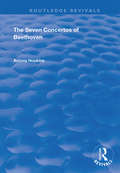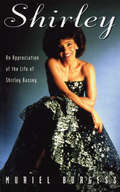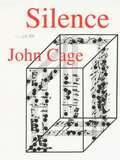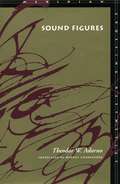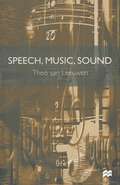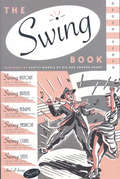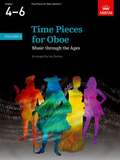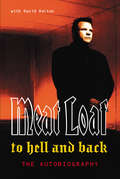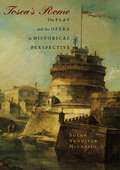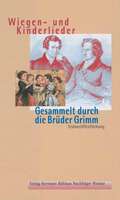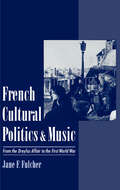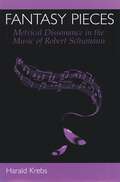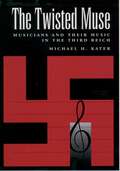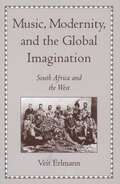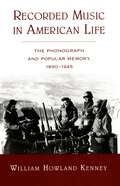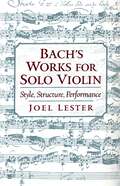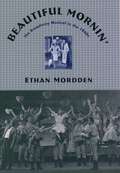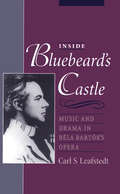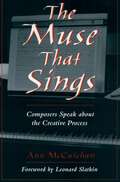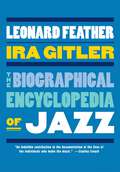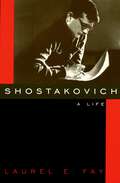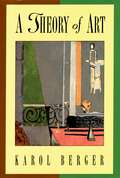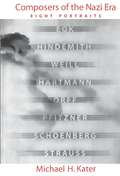- Table View
- List View
The Seven Concertos of Beethoven (Routledge Revivals)
by Antony HopkinsFirst published in 1996, this volume counters the attitude of paying more attention to the performer than to the piece. Too often, Anthony Hopkins argues, music is simply regarded as a pleasant background noise to accompany our other activities, whereas Beethoven offers much more than that. Hopkins aim to promote hearing, rather than listening. He examines Beethoven’s piano concertos numbers 1 through 5, along with the violin concerto in D Major, Op. 61, and the Triple Concerto, Op. 56.
The Seven Concertos of Beethoven (Routledge Revivals)
by Antony HopkinsFirst published in 1996, this volume counters the attitude of paying more attention to the performer than to the piece. Too often, Anthony Hopkins argues, music is simply regarded as a pleasant background noise to accompany our other activities, whereas Beethoven offers much more than that. Hopkins aim to promote hearing, rather than listening. He examines Beethoven’s piano concertos numbers 1 through 5, along with the violin concerto in D Major, Op. 61, and the Triple Concerto, Op. 56.
Shirley: An Appreciation Of The Life Of Shirley Bassey
by Muriel BurgessShirley Bassey is one of the all-time greats of the entertainment business. She has sold more records than any other British female singer and still commands massive audiences around the world. Now, after a career spanning decades, her life story can be told: the story of a triumph over enough tragedies to last several lifetimes. The personal hardships that have fuelled the emotionalism of her songs have never before been revealed. Here her poverty-stricken childhood in Wales is detailed: how her mother struggled to bring up seven children on Income Support after their Nigerian father was deported; how she worked in a saucepan factory when her first struggles for stardom were halted by her pregnancy at sixteen. Shirley had a series of tortured loves: she married a homosexual Cockney who died of an overdose; she had a highly publicised affair with actor Peter Finch; and her second marriage, to an Italian, also failed. The shocking death of her second daughter, Samantha, just before her 21st birthday caused Shirley to lose her voice for nearly a year. Behind the showbiz glamour and consummate professionalism lies a fiercely resilient and independent woman.
Silence : lectures and writings (PDF)
by Cage JohnJohn Cage, a leading figure of the American musical avant-garde and lecturer and writer extraordinary, dedicated himself to the search for new horizons in musical composition. His method of composition: an amalgam of chance operations, latitude in performace, the use of electronic sound and the inclusion of ambient noise. His aim: to increase the territory of his art and to celebrate the richness of life. Silence is a collection of some of the essays and lectures that have made John Cage's name synonymous with all that is unpredictable and exciting in contemporary miusic. Outrageous they may be, but to anyone who is receptive to new ideas, to fresh and original ways of looking at and listening to things, they are a mine of fascinating discovery. And, as Cage fans will expect, the book also contains a wealth of handy information on collecting mushrooms, fishing through ice, and so on, as well as many anecdotes and Zen-type stories which illustrate Cage's exuberant artistic pre-occupations. For everywhere in this mighty explosion of ideas can be heard the still, small voice of the poet, telling with fervour his amazement at creation, when 'everything was given away'.
The Social and Religious Designs of J. S. Bach's Brandenburg Concertos
by Michael MarissenThis new investigation of the Brandenburg Concertos explores musical, social, and religious implications of Bach's treatment of eighteenth-century musical hierarchies. By reference to contemporary music theory, to alternate notions of the meaning of "concerto," and to various eighteenth-century conventions of form and instrumentation, the book argues that the Brandenburg Concertos are better understood not as an arbitrary collection of unrelated examples of "pure" instrumental music, but rather as a carefully compiled and meaningfully organized set. It shows how Bach's concertos challenge (as opposed to reflect) existing musical and social hierarchies. Careful consideration of Lutheran theology and Bach's documented understanding of it reveals, however, that his music should not be understood to call for progressive political action. One important message of Lutheranism, and, in this interpretation, of Bach's concertos, is that in the next world, the heavenly one, the hierarchies of the present world will no longer be necessary. Bach's music more likely instructs its listeners how to think about and spiritually cope with contemporary hierarchies than how to act upon them. In this sense, contrary to currently accepted views, Bach's concertos share with his extensive output of vocal music for the Lutheran liturgy an essentially religious character.
Sound Figures (Meridian: Crossing Aesthetics)
by Theodor W. AdornoTheodor Adorno is one of this century's most influential thinkers in the areas of social theory, philosophy, aesthetics, and music. Throughout the essays in this book, all of which concern musical matters, he displays an astonishing range of cultural reference, demonstrating that music is invariably social, political, even ethical. Adorno's insistence on the social character of aesthetic works will come as no surprise to those familiar with his writings, although many may be surprised by the volume's somewhat colloquial tone. This colloquialism, in dialogue with Adorno's unceasing rigor, stems from the occasional sources of many of the essays, mainly public lectures and radio addresses. As such, this volume represents an important and, for English-language readers, largely unfamiliar side to Adorno. His arguments move more quickly than in his more formal and extended musicological works, and the writing is much more accessible and generous than his usually dense and frequently opaque prose. This volume includes essays on prominent figures in music (Alban Berg, Anton von Webern, Arturo Toscanini), compositional technique (the prehistory of the twelve-tone row, the function of counterpoint in new music), and the larger questions of musical sociology for which Adorno is most famous, including the relation of interpretation to audience, the ideological function of opera, and the historical meaning of musical technique. The essay on the sociology of music, for example, represents an early statement of what would soon become trademark principles of his mode of musical analysis, serving as a catalyst for his famous study Introduction to the Sociology of Music. Some forty years after most of these essays were written, they remain fresh and relevant. In part, this is because Adorno's method has only recently begun to make substantial inroads into Anglo-American musicology. And the interdisciplinary nature of his thought provides a precursor for today's interdisciplinary studies.
Speech, Music, Sound
by Theo Van LeeuwenThis book explores what speech, music and other sounds have in common. It gives a detailed description of the way perspective, rhythm, textual quality and other aspects of sound are used to communicate emotion and meaning. It draws on a wealth of examples from radio (disk jockey and newsreading speech, radio plays, advertising jingles, news signature tunes), film soundtracks (The Piano, The X-files, Disney animation films), music ranging from medieval plain chant to drum 'n' bass and everyday soundscapes.
The Swing Book
by Degen PenerDocuments the history of swing music and dancing, covering the important artists, style and fashion, albums, and dance moves of swing
Time Pieces for Oboe, Volume 2: Music through the Ages (Time Pieces)
by AbrsmThe second of a two-volume anthology presenting attractive repertoire for oboe and piano from the sixteenth century to the present day. Each volume presents the pieces in chronological order and prints the year in which they were written, giving a feel of different styles of music through time.
To Hell And Back: An Autobiography
by David Dalton Meat LoafMeat Loaf's bizarre and spectacular life story is scarcely credible. After surviving an abusive childhood, during which he was almost murdered by his alcoholic father, he starred in one of the biggest stage and film musicals ever, then went on to record the third best-selling album of all time.To Hell and Back is the true story of a man who ran away from a cruel home life at 17 and starred in the legendary Rocky Horror Picture Show before turning to rock 'n' roll. His first album, Bat Out Of Hell, was considered so uncommercial by his first record label that they dropped him - only for it to go on to sell 20 million copies worldwide. He then spent the 1980s on the skids, with a severe drink and drugs problem and mounting money problems leading him to a nervous breakdown, before making a triumphant comeback with 1993's album Bat Out Of Hell II and colossal hit single 'I'd Do Anything For Love'.This is an extraordinary story and a classic rock autobiography.
Tosca's Rome: The Play and the Opera in Historical Perspective
by Susan Vandiver NicassioA timeless tale of love, lust, and politics, Tosca is one of the most popular operas ever written. In Tosca's Rome, Susan Vandiver Nicassio explores the surprising historical realities that lie behind Giacomo Puccini's opera and the play by Victorien Sardou on which it is based. By far the most "historical" opera in the active repertoire, Tosca is set in a very specific time and place: Rome, from June 17 to 18, 1800. But as Nicassio demonstrates, history in Tosca is distorted by nationalism and by the vehement anticlerical perceptions of papal Rome shared by Sardou, Puccini, and the librettists. To provide the historical background necessary for understanding Tosca, Nicassio takes a detailed look at Rome in 1800 as each of Tosca's main characters would have seen it—the painter Cavaradossi, the singer Tosca, and the policeman Scarpia. Finally, she provides a scene-by-scene musical and dramatic analysis of the opera. "[Nicassio] must be the only living historian who can boast that she once sang the role of Tosca. Her deep knowledge of Puccini's score is only to be expected, but her understanding of daily and political life in Rome at the close of the 18th century is an unanticipated pleasure. She has steeped herself in the period and its prevailing culture-literary, artistic, and musical-and has come up with an unusual, and unusually entertaining, history."—Paul Bailey, Daily Telegraph "In Tosca's Rome, Susan Vandiver Nicassio . . . orchestrates a wealth of detail without losing view of the opera and its pleasures. . . . Nicassio aims for opera fans and for historians: she may well enthrall both."—Publishers Weekly "This is the book that ranks highest in my estimation as the most in-depth, and yet highly entertaining, journey into the story of the making of Tosca."—Catherine Malfitano "Nicassio's prose . . . is lively and approachable. There is plenty here to intrigue everyone-seasoned opera lovers, musical novices, history buffs, and Italophiles."—Library Journal
Wiegen-und Kinderlieder: Gesammelt durch die Brüder Grimm
by Heinz Rölleke Jacob und GrimmEine aufsehenerregende Trouvaille: Zum ersten Mal werden die von den Brüdern Grimm zwischen 1807 und 1830 gesammelten Wiegen- und Kinderlieder in einer umfassend kommentierten, mit zeitgenössischen Illustrationen ausgestatteten Ausgabe der Öffentlichkeit zugänglich gemacht.
French Cultural Politics and Music: From the Dreyfus Affair to the First World War
by Jane F. FulcherThis book draws upon both musicology and cultural history to argue that French musical meanings and values from 1898 to 1914 are best explained not in terms of contemporary artistic movements but of the political culture. During these years, France was undergoing many subtle yet profound political changes. Nationalist leagues forged new modes of political activity, as Jane F. Fulcher details in this important study, and thus the whole playing field of political action was enlarged. Investigating this transitional period in light of several recent insights in the areas of French history, sociology, political anthropology, and literary theory, Fulcher shows how the new departures in cultural politics affected not only literature and the visual arts but also music. Having lost the battle of the Dreyfus affair (legally, at least), the nationalists set their sights on the art world, for they considered France's artistic achievements the ideal means for furthering their conception of "French identity." French Cultural Politics and Music: From the Dreyfus Affair to the First World War illustrates the ways in which the nationalists effectively targeted the music world for this purpose, employing critics, educational institutions, concert series, and lectures to disseminate their values by way of public and private discourses on French music. Fulcher then demonstrates how both the Republic and far Left responded to this challenge, using programs and institutions of their own to launch counterdiscourses on contemporary musical values. Perhaps most importantly, this book fully explores the widespread influence of this politicized musical culture on such composers as d'Indy, Charpentier, Magnard, Debussy, and Satie. By viewing this fertile cultural milieu of clashing sociopolitical convictions against the broader background of aesthetic rivalry and opposition, this work addresses the changing notions of "tradition" in music--and of modernism itself. As Fulcher points out, it was the traditionalist faction, not the Impressionist one, that eventually triumphed in the French musical realm, as witnessed by their "defeat" of Stravinsky's Rite of Spring.
Fantasy Pieces: Metrical Dissonance in the Music of Robert Schumann
by Harald KrebsFantasy Pieces examines from several vantage points a vital life-force of Robert Schumann's music, namely metrical conflict. Harald Krebs's imaginative yet rigorous study makes use of Schumann's fascinating projections of his own personality--the characters Florestan and Eusebius--as one means of addressing the biographical and aesthetic context of the music. In counterpoint with the remarks of these personae, Krebs develops an original theory of metrical conflict by adapting the concepts of consonance and dissonance to metrical analysis. He investigates how states of metrical dissonance arise, and shows how they are manipulated and resolved in the course of compositions. He offers new methods for understanding the metrical progressions of entire works or movements, and studies the interaction of metrical conflict with form, with pitch structure, and with the texts of Schumann's vocal works. Krebs includes a wealth of illustrations from the whole range of Schumann's work and offers numerous insights important for performance. In the final chapter, he provides richly detailed studies of pieces by Schumann in various genres, interspersing them with shorter discussions of music by Berlioz, Chopin, Clara Schumann, Ives, and Schoenberg. This is a book that will appeal not only to students and scholars of music theory, but to all musicians interested in the life, work, and unique personality of Robert Schumann.
The Twisted Muse: Musicians and Their Music in the Third Reich
by Michael H. KaterIs music removed from politics? To what ends, beneficent or malevolent, can music and musicians be put? In short, when human rights are grossly abused and politics turned to fascist demagoguery, can art and artists be innocent? These questions and their implications are explored in Michael Kater's broad survey of musicians and the music they composed and performed during the Third Reich. Great and small--from Valentin Grimm, a struggling clarinetist, to Richard Strauss, renowned composer--are examined by Kater, sometimes in intimate detail, and the lives and decisions of Nazi Germany's professional musicians are laid out before the reader. Kater tackles the issue of whether the Nazi regime, because it held music in crassly utilitarian regard, acted on musicians in such a way as to consolidate or atomize the profession. Kater's examination of the value of music for the regime and the degree to which the regime attained a positive propaganda and palliative effect through the manner in which it manipulated its musicians, and by extension, German music, is of importance for understanding culture in totalitarian systems. This work, with its emphasis on the social and political nature of music and the political attitude of musicians during the Nazi regime, will be the first of its kind. It will be of interest to scholars and general readers eager to understand Nazi Germany, to music lovers, and to anyone interested in the interchange of music and politics, culture and ideology.
Music, Modernity, and the Global Imagination: South Africa and the West
by Veit ErlmannHow was Africa seen by the West during the colonial period? How do Europeans and Americans conceive of Africa in today's postcolonial era? Such questions have preoccupied anthropologists, historians, and literary scholars for years. But few have asked the reverse: how did--and do--Africans see Europe and the United States? Fewer still have wondered how Western images of Africa and African representations of the West might mirror one another. In a detailed study spanning from the late nineteenth century to the present, renowned anthropologist and ethnomusicologist Veit Erlmann examines the very creation of a global imagination for black South Africans, Europeans, and African Americans. To this end, he explores two striking episodes in the history of black South African music. The first is a pair of tours made by two black South African choirs in England and America in the early 1890s; the second is a series of engagements with the international music industry as experienced by the premier choral group Ladysmith Black Mambazo after the release of Paul Simon's celebrated Graceland album in 1986. Readers will find the cast of characters involved in these intertwined and international dramas at once telling and impressive. Among the many players are African National Congress co-founder Saul Msane, Queen Victoria, African-American musician and impresario Orpheus McAdoo, Xhosa Christian prophet Ntsikana, W. E. B. Du Bois, Michael Jackson, and Spike Lee. Music, Modernity, and the Global Imagination tells the story of how these artists, activists, and agents effectively invented each other in travel diaries, religious hymns, concert performances, music videos, Broadway plays, and autobiographies. Erlmann also argues that the resultant mixture of myths and fictions--as distinctly imagined by these diverse historical actors--entangled South Africa and the West in ways that often obscured the newly emergent global imbalances of power, or else blurred the polarities of the colonial and postcolonial world. Ultimately, this book reports on a transatlantic dialogue that carries direct and profound implications for the world's arts and cultures. It is the black diasporic discussion between South Africa and the West, and it is a conversation--about society, music, and Utopia--that is still in progress.
Recorded Music in American Life: The Phonograph and Popular Memory, 1890-1945
by William Howland KenneyHave records, compact discs, and other sound reproduction equipment merely provided American listeners with pleasant diversions, or have more important historical and cultural influences flowed through them? Do recording machines simply capture what's already out there, or is the music somehow transformed in the dual process of documentation and dissemination? How would our lives be different without these machines? Such are the questions that arise when we stop taking for granted the phenomenon of recorded music and the phonograph itself. Now comes an in-depth cultural history of the phonograph in the United States from 1890 to 1945. William Howland Kenney offers a full account of what he calls "the 78 r.p.m. era"--from the formative early decades in which the giants of the record industry reigned supreme in the absence of radio, to the postwar proliferation of independent labels, disk jockeys, and changes in popular taste and opinion. By examining the interplay between recorded music and the key social, political, and economic forces in America during the phonograph's rise and fall as the dominant medium of popular recorded sound, he addresses such vital issues as the place of multiculturalism in the phonograph's history, the roles of women as record-player listeners and performers, the belated commercial legitimacy of rhythm-and-blues recordings, the "hit record" phenomenon in the wake of the Great Depression, the origins of the rock-and-roll revolution, and the shifting place of popular recorded music in America's personal and cultural memories. Throughout the book, Kenney argues that the phonograph and the recording industry served neither to impose a preference for high culture nor a degraded popular taste, but rather expressed a diverse set of sensibilities in which various sorts of people found a new kind of pleasure. To this end, Recorded Music in American Life effectively illustrates how recorded music provided the focus for active recorded sound cultures, in which listeners shared what they heard, and expressed crucial dimensions of their private lives, by way of their involvement with records and record-players. Students and scholars of American music, culture, commerce, and history--as well as fans and collectors interested in this phase of our rich artistic past--will find a great deal of thorough research and fresh scholarship to enjoy in these pages.
Bach's Works for Solo Violin: Style, Structure, Performance
by Joel LesterJ. S. Bach's sonatas and partitas for solo violin have been central to the violin repertoire since the mid-eighteenth century. This engaging volume is the first comprehensive exploration of the place of these works within Bach's music: it focuses on their structural and stylistic features as they have been perceived since their creation. Joel Lester, a highly regarded scholar, teacher, violinist, and administrator, combines an analytical study, a full historical guide, and an insightful introduction to Bach's style. Individual movements are related to comparable movements by Bach in other media and are differentiated from superficially similar works from later eras. Lester employs descriptions of historical and contemporary recordings, as well as accounts of nineteenth-century performances and commentaries on historical editions, to explore these works as they evolved through the centuries. Wherever possible, he uses analytic tools culled from eighteenth-century ideas, key notions originally developed for the specific purpose of describing the repertoire under consideration. Beginning with an overview of the solo violin music's place within Bach's oeuvre, this study takes the Sonata No. 1 in G minor as the paradigm of Bach's compositional strategy, examining each movement in detail before enlarging the discussion to cover parallel and contrasting features of the A-minor and C-minor sonatas. Next, a chapter is devoted to the three partitas and their roots in various dance-music traditions. The book concludes with a summary of form, style, and rhetoric in Bach's music, in which Lester muses on these masterpieces with an overall command of the music, criticism, and history of the 1700s that is quite rare among scholars. A novel and unprecedented investigation of a particular portion of Bach's accomplishment and a particular aspect of his universal appeal, Bach's Works for Solo Violin will help violinists, students, scholars, and other listeners develop a deeper personal involvement with these wonderful pieces.
Beautiful Mornin': The Broadway Musical in the 1940s
by Ethan Mordden"Music and girls are the soul of musical comedy," one critic wrote, early in the 1940s. But this was the age that wanted more than melody and kickline form its musical shows. The form had been running on empty for too long, as a formula for the assembly of spare parts--star comics, generic love songs, rumba dancers, Ethel Merman. If Rodgers and Hammerstein hadn't existed, Broadway would have had to invent them; and Oklahoma! and Carousel came along just in time to announce the New Formula for Writing Musicals: Don't have a formula. Instead, start with strong characters and atmosphere: Oklahoma!'s murderous romantic triangle set against a frontier society that has to learn what democracy is in order to deserve it; or Carousel's dysfunctional family seen in the context of class and gender war. With the vitality and occasionally outrageous humor that Ethan Mordden's readers take for granted, the author ranges through the decade's classics--Pal Joey, Lady in the Dark, On the Town, Annie Get Your Gun, Phinian's Rainbow, Brigadoon, Kiss Me, Kate, South Pacific. He also covers illuminating trivia--the spy thriller The Lady Comes Across, whose star got so into her role that she suffered paranoid hallucinations and had to be hospitalized; the smutty Follow the Girls, damned as "burlesque with a playbill" yet closing as the longest-run musical in Broadway history; Lute Song, in which Mary Martin and Nancy Reagan were Chinese; and the first "concept" musicals, Allegro and Love Life. Amid the fun, something revolutionary occurs. The 1920s created the musical and the 1930s gave it politics. In the 1940s, it found its soul.
Inside Bluebeard's Castle: Music and Drama in Béla Bartók's Opera
by Carl S. LeafstedtThis is the first book-length examination of Bartók's 1911 opera Duke Bluebeard's Castle, one of the twentieth century's enduring operatic works. Writing in an engaging style, Leafstedt adopts an interdisciplinary approach to the opera by introducing, in addition to music-dramatic analysis, a number of topics that are new to the field of Bartók studies. These new areas of critical and scholarly terrain include a detailed literary study of the libretto and a gender-focused analysis of the opera's female character, Judith. Leafstedt begins with a short introductory chapter that places Duke Bluebeard's Castle within the context of Bartók's early composing career, his discovery of folk music, and its impact on his later work. The book goes on to explore the composition's troubled history, its failure to win two early Hungarian opera competitions, and the three versions of the ending that resulted, discussed here in depth for the first time. The core of the book is devoted to the musical and dramatic organization of the opera and offers an analysis of the seven individual door scenes, including a detailed analysis of scene six, the "lake of tears" scene, illustrating the work's complex tonal organization and dramatic structure. A separate chapter places this darkly psychological version of the Bluebeard story within the broader context of European history and literature. Throughout the book, Leafstedt draws on original Hungarian source material, much of it newly translated by the author and available here for the first time in English, and he includes a generous selection of musical examples. Inside Bluebeard's Castle is an ideal starting point for research in twentieth-century music, Hungarian cultural history, and opera studies, as well as an invaluable guide for anyone interested in Bartók's only opera.
The Muse that Sings: Composers Speak about the Creative Process
by Ann McCutchanThe Muse That Sings is a unique behind-the-scenes look at both twentieth-century music and the nuts and bolts of creative work. Here, twenty-five of America's leading composers--from Adams to Zorn, from Bolcom to Vierk--talk candidly about their craft, their motivations, their difficulties, and how they how proceed from musical idea to finished composition. While focusing on the process and the stories behind specific works, the composers also touch on topics that will interest anyone involved in creative work. They discuss teachers and mentors, the task of revision, relationships with performers, and the ongoing struggle for a balance between freedom and discipline. They reveal sources of inspiration, artistic goals, and the often unexpected ways their musical ideas develop. Some describe personal tonal systems; others discuss the impact of computers and other electronic tools on their work; still others reflect philosophically on the inner impulses and outer influences that continue to drive them. While serious music has a reputation for being difficult and inaccessible, The Muse That Sings provides a powerful antidote. The composers in this book speak clearly and thoughtfully in response to key questions of concern to all readers interested in contemporary music. Each interview has been edited to stand alone as a concise meditation on muse and technique, and the book includes selected discographies as well as brief biographical sketches. Anyone with an interest in twentieth-century music or in the creative process will find this lively collection a valuable source of inspiration and insight.
The Biographical Encyclopedia of Jazz
Do you want to know when Duke Ellington was king of The Cotton Club? Have you ever wondered how old Miles Davis was when he got his first trumpet? From birth dates to gig dates and from recordings to television specials, Leonard Feather and Ira Gitler have left no stone unturned in their quest for accurate, detailed information on the careers of 3.300 jazz musicians from around the world. We learn that Duke Ellington worked his magic at The Cotton Club from 1927 to 1931, and that on Miles Davis's thirteenth birthday, his father gave him his first trumpet. Jazz is fast moving, and this edition clearly and concisely maps out an often dizzying web of professional associations. We find, for instance, that when Miles Davis was a St. Louis teenager he encountered Charlie Parker and Dizzy Gillespie for the first time. This meeting proved fateful, and by 1945 a nineteen-year-old Davis had left Juilliard to play with Parker on 52nd Street. Knowledge of these professional alliances, along with the countless others chronicled in this book, are central to tracing the development of significant jazz movements, such as the "cool jazz" that became one of Miles Davis's hallmarks. Arranged alphabetically according to last name, each entry of this book chronologically lists the highlights of every jazz musician's career. Highly accessible and vigorously researched, The Biographical Encyclopedia of Jazz is, quite simply, the most comprehensive jazz encyclopedia available.
Shostakovich: A Life
by Laurel FayFor this authoritative post-cold-war biography of Shostakovich's illustrious but turbulent career under Soviet rule, Laurel E. Fay has gone back to primary documents: Shostakovich's many letters, concert programs and reviews, newspaper articles, and diaries of his contemporaries. An indefatigable worker, he wrote his arresting music despite deprivations during the Nazi invasion and constant surveillance under Stalin's regime. Shostakovich's life is a fascinating example of the paradoxes of living as an artist under totalitarian rule. In August 1942, his Seventh Symphony, written as a protest against fascism, was performed in Nazi-besieged Leningrad by the city's surviving musicians, and was triumphantly broadcast to the German troops, who had been bombarded beforehand to silence them. Alone among his artistic peers, he survived successive Stalinist cultural purges and won the Stalin Prize five times, yet in 1948 he was dismissed from his conservatory teaching positions, and many of his works were banned from performance. He prudently censored himself, in one case putting aside a work based on Jewish folk poems. Under later regimes he balanced a career as a model Soviet, holding government positions and acting as an international ambassador with his unflagging artistic ambitions. In the years since his death in 1975, many have embraced a view of Shostakovich as a lifelong dissident who encoded anti-Communist messages in his music. This lucid and fascinating biography demonstrates that the reality was much more complex. Laurel Fay's book includes a detailed list of works, a glossary of names, and an extensive bibliography, making it an indispensable resource for future studies of Shostakovich.
A Theory of Art
by Karol BergerWhat, if anything, has art to do with the rest of our lives, and in particular with those ethical and political issues that matter to us most? Will art created today be likely to play a role in our lives as profound as that of the best art of the past? A Theory of Art shifts the focus of aesthetics from the traditional debate of "what is art?" to the engaging question of "what is art for?" Skillfully describing the social and historical situation of art today, author Karol Berger argues that music exemplifies the current condition of art in a radical, acute, and revealing fashion. He also uniquely combines aesthetics with poetics and hermeneutics. Offering a careful synthesis of a wide breadth of scholarship from art history, musicology, literary studies, political philosophy, ethics, and metaphysics, and written in a clear, accessible style, this book will appeal to anyone with a serious interest in the arts.
Composers of the Nazi Era: Eight Portraits
by Michael H. KaterHow does creativity thrive in the face of fascism? How can a highly artistic individual function professionally in so threatening a climate? Composers of the Nazi Era is the final book in a critically acclaimed trilogy that includes Different Drummers (OUP 1992) and The Twisted Muse (OUP 1997), which won the Wallace K. Ferguson Prize of the Canadian Historical Association. Here, historian Michael H. Kater provides a detailed study of the often interrelated careers of eight prominent German composers who lived and worked amid the dictatorship of the Third Reich, or were driven into exile by it: Werner Egk, Paul Hindemith, Kurt Weill, Karl Amadeus Hartmann, Carl Orff, Hans Pfitzner, Arnold Schoenberg, and Richard Strauss. Kater weighs issues of accommodation and resistance to ask whether these artists corrupted themselves in the service of a criminal regime--and if so, whether this may be discerned from their music. After chapters discussing the circumstances of each composer individually, Kater concludes with an analysis of the composers' different responses to the Nazi regime and an overview of the sociopolitical background against which they functioned. The final chapter also extends the discussion beyond the end of World War II to examine how the composers reacted to the new and fragile democracy in Germany.
